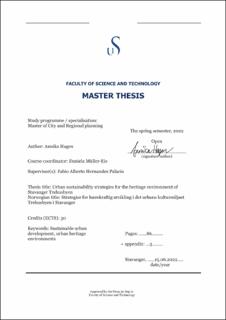| dc.description.abstract | This master thesis presents research on cultural heritage environments in urban settings. The setting is the wooden house city of Stavanger, known as Trehusbyen, with historical buildings surrounding the city centre. The aim was to find an approach to how a heritage environment like Trehusbyen in Stavanger could cope with new standards for sustainable city development.
The theoretical framework is based on sustainable development and cultural heritage in existing urban environments, with relevant literature and reference cases. The analysis is based on the existing situation of the wooden house city of Stavanger, and qualitative aspects from experts involved in planning- and development processes related to Trehusbyen. Historically, Trehusbyen possess some of the qualities and abilities associated with modern standards for sustainability. The flexibility and design give a possibility to mix functions and reduce travel distances for everyday purposes, while the human scale contribute to making the areas more attractive for soft mobility. The buildings and streets were found to be capable of adapting to changes, but varying aspects of cultural heritage called for detailed clarifications to find adaptations that preserved these qualities.
It was found that within the cultural heritage there is room for development that preserves the existing values, but this is a complex issue. There was a need for further detailing of the specific heritage values to be considered and what potential for sustainable urban development could be conciliated with these. This thesis presents a design framework for how Stavanger Trehusbyen can cope with sustainability standards by defining the specific potential within a building, block, and neighborhood radius. The foundation of the framework was based on the cultural heritage to be used as a resource in sustainable city planning, and the value and importance of cultural heritage set the base for the potentials for development. This also includes possible interventions for enhancing new standards for sustainability. While densification is the general strategy for enhancing urban sustainability standards, this was not the only ideal measure to increase sustainability standards of Trehusbyen. | |
